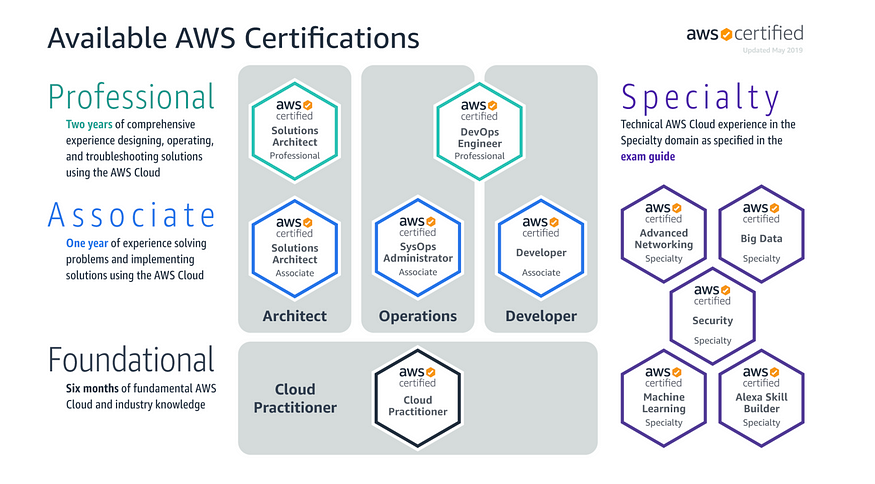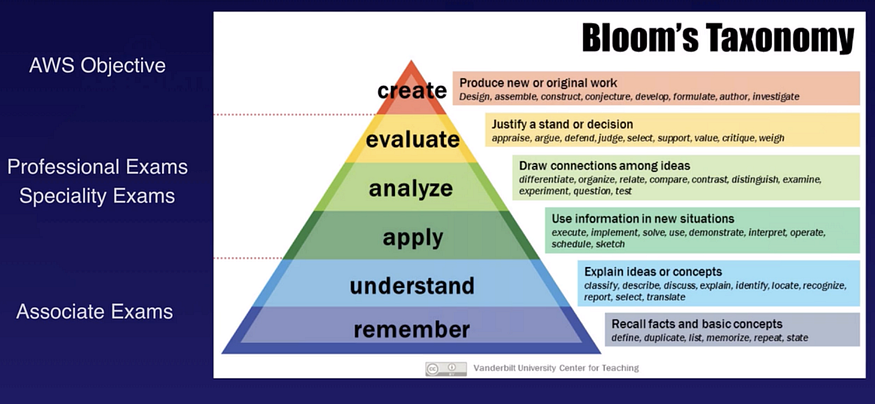
AWS Certification Roadmap (as of May 2019)
Last Updated on July 25, 2023 by Editorial Team
Author(s): Tina Bu
Originally published on Towards AI.
Cloud Computing
AWS Certified Solutions Architect Associate U+007C Exam Tips 2019
Exam tips for the Amazon Web Services Solutions Architect Associate certification
I just passed my AWS Certified Solutions Architect Associate exam U+1F44FU+1F3FBU+1F44FU+1F3FBU+1F44FU+1F3FB and I want to share my experience and exam preparation tips with you. Currently, the platform has more than 140 different services and new services are launching every day. It can be very overwhelming trying to understand the whole ecosystem. If you haven’t got a lot of opportunities to use AWS at work, taking the solutions architect associate exam is actually not a bad place to get yourself acquainted with the platform.
In this post, I am going to briefly introduce the different certification exams AWS offers, then talk about resources that helped me to pass my exam, which hopefully will help you pass yours. U+1F31F
My background: I am a data scientist and my hands-on AWS experience is very limited to mostly EC2. I don’t really work with storage and networking solutions. I certainly don’t design critical large scale high performance production systems. Most of the stuff I learned getting ready for the exam is new to me.

As of 2019, there are 3 paths to get AWS certified — Architect, Operations and Developer and there are 5 specialty exams — Networking, Big Data, Security, Machine Learning and Alexa. I believe that you don’t need to clear the associate level to take the professional exam now but I have heard that the professional level is significantly harder so it might be a good idea to start with the associate ones. It also seems to be the case that for the 3 associate level exams, SysOps is the hardest, followed by the Solutions Architect and the Developer track is relatively the easiest.

A lot of people recommend starting with the solutions architect associate exam as your first certificate because it tests on the most important AWS offerings and focuses on “how services work together, to provide the best (and cost-effective) solution for the situation presented.” And that’s exactly where I chose to start my AWS path. Read this post to learn more about which certification exam you should take.
Solutions Architect Associate Exam Overview
Example question U+1F9D0
Your web application front end consists of multiple EC2 instances behind an Elastic Load Balancer. You configured ELB to perform health checks on these EC2 instances. If an instance fails to pass health checks, which statement will be true?
A. The instance is replaced automatically by the ELB.
B. The instance gets terminated automatically by the ELB.
C. The ELB stops sending traffic to the instance that failed its health check.
D. The instance gets quarantined by the ELB for root cause analysis
The above question is taken from the official AWS sample exam questions. In your real exam, the question is either going to be “given the requirement and constraint, how will you design or improve this system” or “given a system, explaining why certain behavior/bug/bottleneck is happening”. The most important thing is to understand the requirement and constraint in regards to performance, scalability, availability, cost, and security.
There will be 65 questions and you have 130 minutes. All of them are either single or multiple-choice questions. ~65% would generally be a passing score.
My take is that if you have some relative experience with AWS and basic knowledge about networking and database, passing the exam in 1 to 2 months could be a realistic plan (that’s how long it took me). The key is to focus on what’s important — understanding different services, features, and tradeoffs. AWS is not going to test you on which button to click on to set up a Lambda function or how much your reserved EC2 instance is going to cost. But you need to understand what storage solution would be the best choice given that you are storing image data and won’t require frequent retrieval but when you need the data it has to be available immediately.
Solutions Architect Associate Exam Topics
I think the core services you need to understand very well include:
- EC2 (AZ, auto-scaling, load balancer, security group)
- VPC (subnet, NAT gateway, BastionHost, Network ACL)
- S3 (different S3 classes, encryption, versioning, cross-region replication, lifecycle)
- RDS (multi-AZ, cross-region replication)
Services that you need to understand their basic functionalities include:
- Storage: Glacier, DynamoDB, Storage gateway, Aurora, ElastiCache, Redshift, EFS
- Compute: Lambda, ECS, Elastic Beanstalk
- Networking: Route53, API Gateway, CloudFront
- Management & Monitoring: IAM, CloudWatch, CloudFormation, KMS
- Analytics: Kinesis, Athena
- Applications: SQS, SNS
I understand it’s a lot of especially with the random U+1F525 names AWS people gave their products. What is Snowball U+2603️? What is Kinesis U+1F52C? There is a service called Athena U+1F9DAU+2640️? Why do some services start with Amazon and some start with AWS? Amazon SageMaker but AWS RoboMaker, Amazon Redshift but AWS Auto Scaling? Why completely different things have very similar names? NAT Gateway, Storage Gateway, Internet Gateway, and API Gateway? Why some services have abbreviation names some have spaces in their names some have CamelCase names some even have dashes in their names? Ok “E” is “elastic” in EMR, ECS, EKS, ECR, and EFS but what about ElastiCache (how to pronounce these AWS people?) and Elastic Beanstalk? Shouldn’t it be EC and EB instead? Why there are so many services with “Cloud” in their name? Aren’t everything here cloud U+2601️ already? Ok EC2 means 2 Cs and S3 is 3 Ss, but what is Cloud9 and what about Route53? I am going to stop complaining now but do read this post for constructive AWS naming feedback and check out AWS in plain English if you agree AWS naming sucks U+1F62C.
Preparation Resources
- aCloudGuru course by Ryan Kroonenburg U+1F468U+1F3EB: extremely up to date (the instructor takes the exam frequently and updates the content); gives a great overview of the AWS ecosystem and services; very informative lectures and labs. Highly recommend. Must take. The best AWS preparation course on the whole internet. Only $29 a month what are you thinking just sign up already.
- Tutorials Dojo Practice Questions U+270D️: one of the only shortcomings for the aCloudGuru course is there are not enough practice questions and the Udemy practice questions worked wonder for me. It resembles the real exam very well and has hundreds of practice questions. whizlabs also offers practice questions but I haven’t tried it myself yet.
- AWS mock exam: $20 for 20 questions. You can buy it on the same page you register for the real exam.
- Qwiklab: even though you are not going to be quizzed on the steps to create a service or to build a VPC from scratch, I find doing some labs very helpful, especially for the core services I listed above (EC2, VPC, S3, and RDS).
- Abhishek Shaha’s article on exam tips: great article on exam tips with example questions but it was written in 2016 so some parts may not be exactly up to date.
- A GitHub post with resources to prepare for the exam: open source repos, blogs & blog posts, ebooks, PDF, whitepapers, video courses, free lecture, slides, sample test, and many other resources. There are some re: Invent videos about system design best practices that I find very helpful.
There are a lot more training resources available that I didn’t cover here simply because I haven’t used them. I have heard great reviews about the LinuxAcademy course and labs. A lot of people and AWS themselves included recommend reading the AWS Q&A pages and whitepapers but they are very long and some content may not be directly relevant for the solutions architect associate exam. Let me know in the comments if I missed anything that you found helpful and would like to share!
Logistics Tips
- The exam registration page authenticates you with your Amazon shopping account (weird U+1F6D2). If you have been using a nickname then you need to submit your ID to have it changed.

- The exam is going to happen at a PSI test location. The closest test center for me is one hour away. I would recommend registering for the afternoon exams so you can avoid the morning traffic. U+1F335
- Take your government-issued ID ???? and a credit card U+1F4B3. No electronic IDs allowed. MAKE SURE YOUR LICENSE DIDN’T EXPIRE (No followup questions thank you very much).
- Use the restroom U+1F6BD first because you can’t pause the exam once you start.
- You will be given a pencil U+270F️, a piece of paper U+1F4C3, a calculator U+1F9EE and earplugs U+1F515. I don’t know why a calculator is needed because I was not tested on any pricing question.
- You will know if you passed or not immediately after you submit your answers U+1F976.
- Your certificate is valid for 3️⃣ years. You need to retake the exam or take a professional exam.
- Optional random tip: Practice using the mouse with your opposite hand so you can hold on to your pencil for taking notes and save time switching back and forth.
Fun note: There is a Chinese proverb called “左右開弓” U+1F3F9 which means a person who can “draw a bow with both their left and right hand”. It basically means they are ambidextrous and super competitive and smart.
What Now?
- Create an account to schedule your real and mock exams: AWS Certification & training
- Finish the aCloudGuru course or a course of your choice
- Do some labs (If you can create a VPC with Public and Private Subnets (NAT), a highly available web service with ELB and auto-scaling, a blog site with CloudFront as CND and Route53 as DNS then you are very much good to go.)
- Take the AWS mock exam 2 weeks before your exam to assess your knowledge and test-taking skills
- Practice mock exam questions, a lot of them
- Pass your exam and tell me U+1F64BU+1F3FB how awesome you are
- Use AWS in your real life
It’s not a trivial task to pass the solutions architect exam but passing the exam is just the first step. Especially given that the solutions architect associate exam focuses very heavily on concepts and design choices versus implementation details, it is not guaranteed that after you clear the exam you become a great cloud architect. Getting certified is not going to help you quickly debug what’s wrong in your system. It’s not even going to make you remember to shut down services after you are done. There can be a lot of strategies to help you pass an exam but to truly know how to use AWS, use it for your work or side projects is the best way to learn.
Join thousands of data leaders on the AI newsletter. Join over 80,000 subscribers and keep up to date with the latest developments in AI. From research to projects and ideas. If you are building an AI startup, an AI-related product, or a service, we invite you to consider becoming a sponsor.
Published via Towards AI
Take our 90+ lesson From Beginner to Advanced LLM Developer Certification: From choosing a project to deploying a working product this is the most comprehensive and practical LLM course out there!
Towards AI has published Building LLMs for Production—our 470+ page guide to mastering LLMs with practical projects and expert insights!

Discover Your Dream AI Career at Towards AI Jobs
Towards AI has built a jobs board tailored specifically to Machine Learning and Data Science Jobs and Skills. Our software searches for live AI jobs each hour, labels and categorises them and makes them easily searchable. Explore over 40,000 live jobs today with Towards AI Jobs!
Note: Content contains the views of the contributing authors and not Towards AI.














